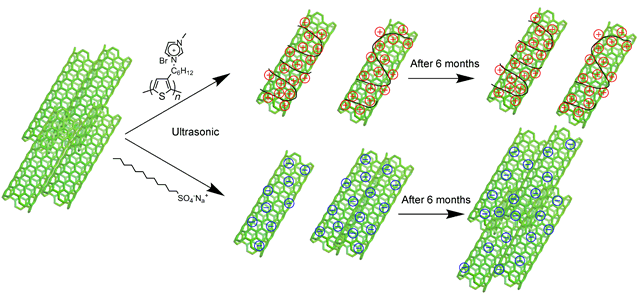| [1] Jariwala, D.; Sangwan, V. K.; Lauhon, L. J.; Marks, T. J.; Hersam, M. C. Chem. Soc. Rev. 2013, 42, 2824.
[2] Qiu, C.; Zhang, Z.; Xiao, M.; Yang, Y.; Zhong, D.; Peng, L. M. Science 2017, 355, 271.
[3] Liu, S.; Guo, X. F. Acta Chim. Sinica 2013, 71, 478(in Chinese). (刘松, 郭雪峰, 化学学报, 2013, 71, 478.)
[4] Zhang, S.; Kang, L.; Wang, X.; Tong, L.; Yang, L.; Wang, Z.; Qi, K.; Deng, S.; Li, Q.; Bai, X.; Ding, F.; Zhang, J. Nature 2017, 543, 234.
[5] Yang, F.; Wang, X.; Zhang, D.; Yang, J.; Luo, D.; Xu, Z.; Peng, F.; Li, X.; Li, R.; Li, Y.; Li, M.; Bai, X.; Ding, F.; Li, Y. Nature 2014, 510, 522.
[6] Li, L.; Jia, G. X.; Wang, X. X.; Wu, T. W.; Song, X. W.; An, S. L. Acta Chim. Sinica 2017, 75, 284(in Chinese). (李磊, 贾桂霄, 王晓霞, 吴铜伟, 宋希文, 安胜利, 化学学报, 2017, 75, 284.)
[7] R?sner, B.; Guldi, D. M.; Chen, J.; Minett, A. I.; Fink, R. H. Nanoscale 2014, 6, 3695.
[8] Sang, W. K.; Kim, T.; Kim, Y. S.; Hong, S. C.; Lim, H. J.; Yang, S. J.; Park, C. R. Carbon 2012, 50, 3.
[9] Guo, L. H.; Gong, L. H.; Yuan, F. L.; Zhang, B.; Bai, X. D.; Lian, Y. F. Acta Chim. Sinica 2005, 63, 1936(in Chinese). (郭丽华, 宫丽红, 袁福龙, 张斌, 白续铎, 廉永福, 化学学报, 2005, 63, 1936.)
[10] Lin, G. F.; Meng, L. J.; Zhang, X. K.; Lu, Q. H. Prog. Chem. 2010, 22, 331(in Chinese). (林高锋, 孟令杰, 张晓科, 路庆华, 化学进展, 2010, 22, 331.)
[11] Singh, P.; Campidelli, S.; Giordani, S.; Bonifazi, D.; Bianco, A.; Prato, M. Chem. Soc. Rev. 2009, 38, 2214.
[12] Liang, L.; Xie, W.; Fang, S.; He, F.; Yin, B.; Tlili, C.; Wang, D.; Qiu, S.; Li, Q. J. Mater. Chem. C 2017, 5, 11339.
[13] Samanta, S. K.; Fritsch, M.; Scherf, U.; Gomulya, W.; Bisri, S. Z.; Loi, M. A. Acc. Chem. Res. 2014, 47, 2446.
[14] Lee, H. W.; Yoon, Y.; Park, S.; Oh, J. H.; Hong, S.; Liyanage, L. S.; Wang, H.; Morishita, S.; Patil, N.; Park, Y. J.; Spakowitz, A.; Galli, G.; Gygi, F.; Wong, P. H.-S.; Tok, J. B.-H.; Kim, J. M.; Bao, Z. Nat. Commun. 2011, 2, 541.
[15] Yang, H.; Bezugly, V.; Kunstmann, J.; Filoramo, A.; Cuniberti, G. ACS Nano 2015, 9, 9012.
[16] Liu, Z.; Li, H.; Qiu, Z.; Zhang, S. L.; Zhang, Z. B. Adv. Mater. 2012, 24, 3633.
[17] Yang, S.; Meng, D.; Sun, J.; Yan, H.; Yong, H.; Geng, J. ACS Appl. Mater. Interfaces 2014, 6, 7686.
[18] Derenskyi, V.; Gomulya, W.; Rios, J. M.; Fritsch, M.; Fr?hlich, N.; Jung, S.; Allard, S.; Bisri, S. Z.; Gordiichuk, P.; Herrmann, A.; Scherf, U.; Loi, M. A. Adv. Mater. 2014, 26, 5969.
[19] Mai, C. K.; Liu, J.; Evans, C. M.; Segalman, R. A.; Chabinyc, M. L.; Cahill, D. G.; Bazan, G. C. Macromolecules 2016, 49, 4957.
[20] Li, Y.; Mai, C. K.; Phan, H.; Liu, X.; Nguyen, T. Q.; Bazan, G. C.; Chan-Park, M. B. Adv. Mater. 2014, 26, 4697.
[21] Kang, Y. K.; Lee, O. S.; Deria, P.; Sang, H. K.; Park, T. H.; Bonnell, D. A.; Saven, J. G.; Therien, M. J. Nano Lett. 2009, 9, 1414.
[22] Deria, P.; Olivier, J. H.; Park, J.; Therien, M. J. J. Am. Chem. Soc. 2014, 136, 14193.
[23] Mai, C. K.; Russ, B.; Fronk, S. L.; Hu, N.; Chan-Park, M. B.; Urban, J. J.; Segalman, R. A.; Chabinyc, M. L.; Bazan, G. C. Energy Environ. Sci. 2015, 8, 2341.
[24] Osaka, I.; Mccullough, R. D. Acc. Chem. Res. 2008, 41, 1202.
[25] He, M.; Zhao, L.; Wang, J.; Han, W.; Yang, Y.; Qiu, F.; Lin, Z. ACS Nano 2010, 4, 3241.
[26] He, M.; Ge, J.; Lin, Z.; Feng, X.; Wang, X.; Lu, H.; Yang, Y.; Qiu, F. Energy Environ. Sci. 2012, 5, 8351.
[27] Pan, S.; He, L.; Peng, J.; Qiu, F.; Lin, Z. Angew. Chem. Int. Ed. 2016, 55, 8686.
[28] Yang, X.; Ge, J.; He, M.; Ye, Z.; Liu, X.; Peng, J.; Qiu, F. Macromolecules 2016, 49, 287.
[29] Zhu, M.; Kim, H.; Yu, J. J.; Park, S.; Du, Y. R.; Kim, K.; Tang, P.; Qiu, F.; Kim, D. H.; Peng, L. J. Mater. Chem. A 2016, 4, 18432.
[30] Xia, H.; Ye, Z.; Liu, X.; Peng, J.; Qiu, F. RSC Adv.2014, 4, 19646.
[31] Duarte, A.; Pu, K. Y.; Liu, B.; Bazan, G. C. Chem. Mater. 2011, 23, 501.
[32] Feng, L.; Zhu, C.; Yuan, H.; Liu, L.; Lv, F.; Wang, S. Chem. Soc. Rev. 2013, 42, 6620.
[33] Rochat, S.; Swager, T. M. ACS Appl. Mater. Interfaces 2013, 5, 4488.
[34] Ghoos, T.; Malinkiewicz, O.; Conings, B.; Lutsen, L.; Vanderzande, D. J.; Bolink, H. J.; Maes, W. RSC Adv. 2013, 3, 25197.
[35] Liang, S.; Zhao, Y.; Adronov, A. J. Am. Chem. Soc. 2014, 136, 970.
[36] Bounioux, C.; Bar-Hen, A.; Yerushalmi-Rozen, R. Chem. Commun. 2015, 51, 6343.
[37] Chen, J.; Liu, H.; Weimer, W. A.; Halls, M. D.; Waldeck, D. H.; Walker, G. C. J. Am. Chem. Soc. 2002, 124, 9034.
[38] Rao, G. P.; Lu, C.; Su, F. Sep. Purif. Technol. 2007, 58, 224. |
